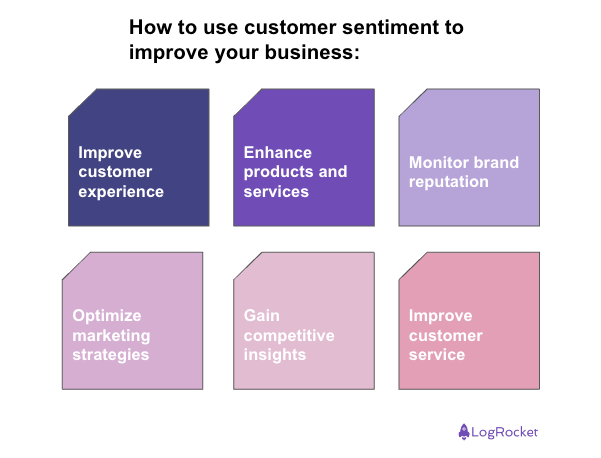Companies strive for positive customer sentiment. As a PM, you want to live in a world where customers write glowing reviews and recommend your product to everyone they know. However, sometimes poor interactions can lead to neutral or negative feelings about a brand. And ultimately, these perceptions can affect a company’s bottom line.

Understanding customer sentiment is crucial to knowing how customers feel about your company. There’s a plethora of data from social media posts, reviews, and other digital channels. Analyzing this data can make a significant impact on how you drive forward positive customer experiences.
In this article, you’ll explore the importance of customer sentiment and the different types of sentiment models. We’ll also discuss strategies to collect, measure, and act on customer sentiment.
Customer sentiment reflects how customers perceive a company and its products. It’s more than just a metric of a customer’s attitude towards a brand. Customer sentiment is about gaining a deeper understanding of the customer. It delves into why customers behave the way they do and what matters to them.
Customer sentiment evaluates a company’s marketing campaigns, product development, and customer support. If any of them are found to be unsatisfactory, it can impact the customer experience and your bottom line.
Customer sentiment and customer satisfaction seem similar, but they have different goals. Customer satisfaction often focuses on one interaction or feature. Then it determines if a customer finds it acceptable or not.
Meanwhile, customer sentiment focuses on the overall experience of customers and their opinions of a brand. It’s more holistic and evaluates the underlying feelings of customers.
There are multiple types of customer sentiment models. Here are the most common types of customer sentiment analysis models:
Customer sentiment provides valuable insights into how customers feel about your brand. Without this knowledge, managers will struggle to connect with customers. They also won’t be able to provide services that meet customer needs.
There are multiple ways to use customer sentiment to improve your business. Some of these benefits include:

Customer sentiment can provide real-time insights into how customers are experiencing your product. Companies can easily identify issues and work on rectifying them. A quick resolution to problems means that customers are more likely to be satisfied with their experience.
Analyzing feedback for customer sentiment is crucial to optimizing products and services. Managers can use this data to improve or add new features that meet customer needs.
Customer sentiment analysis can often review social media posts and reviews to determine how people view your brand. It’s also useful to track down people with negative experiences and help fix the situation. These actions can help improve your brand reputation online.
Customer sentiment can also be used to measure the success of a marketing campaign. Reviewing how customers feel about your marketing campaigns can help you fine-tune your approach. This helps tailor your messaging and ensure it resonates with your audience.
Customer sentiment can also be used as part of a competitor analysis. Understanding how your competitors are missing the mark can help inform your own product or marketing strategy.
Chatbots are frequently used for customer service, but there comes a time when a situation escalates and a real person needs to help. Machine learning and AI can detect the intent of chat conversations and know when to call in customer support. This can help ensure your customers are having satisfactory support experiences.
Customer sentiment can also help inform re-training for customer support teams. If customers report dissatisfying experiences with customer support, it may be time to retrain the team.
Measuring customer sentiment can be done through several different methods and tools. Some of the most common ways to collect and analyze customer sentiment include:
Most of the time you need to elicit feedback directly from customers. Surveys can get direct feedback, but evaluating customer support interactions can also be useful. Combining different methods helps you build a full picture of customer sentiment.
A proactive approach to evaluating sentiment helps you improve the customer experience. Don’t forget to track customer sentiment over time, so you can identify trends.
Once you’ve gathered the feedback and completed a sentiment analysis, the next step is to implement what you’ve learned. Otherwise, all that work is pretty useless. You need to build an actionable plan to improve or maintain positive customer sentiment.
The action plan can inform marketing strategies, product development, or customer service improvements. Here are a few aspects to consider:
You may also want to make an action plan to turn neutral sentiment into positive sentiment. How can you help turn neutral customers into positive customers? Maybe you need to add a new feature or modernize your product design. Thinking of these ideas can help improve your positive sentiment score.
Sentiment is the driving force behind a customer-centric business model. You can’t create positive interactions with customers if you can’t understand their sentiment. It’s also more difficult to manage issues that customers are facing if you don’t know them.
Proactively surveying customers and monitoring reviews is a part of measuring customer sentiment. It provides you with the data you need to make informed decisions. Managing customer feedback ensures you are building long-term relationships with loyal customers. Those relationships are often rewarded with less churn and more revenue.
Featured image source: IconScout

LogRocket identifies friction points in the user experience so you can make informed decisions about product and design changes that must happen to hit your goals.
With LogRocket, you can understand the scope of the issues affecting your product and prioritize the changes that need to be made. LogRocket simplifies workflows by allowing Engineering, Product, UX, and Design teams to work from the same data as you, eliminating any confusion about what needs to be done.
Get your teams on the same page — try LogRocket today.

A practical framework for PMs to use AI in ideation without sacrificing judgment, strategy, or decision quality.

A practical five minute revenue estimation method to help product managers compare ideas, drop low impact features, and prioritize smarter.

A practical guide for PMs who want to stop being bottlenecks, delegate smarter, and lead teams effectively with a clear ownership framework.

Stop letting unreliable data block features. Treat data as inventory to track quality, ownership, and ship with confidence.